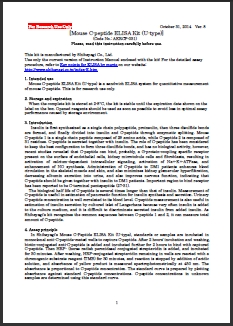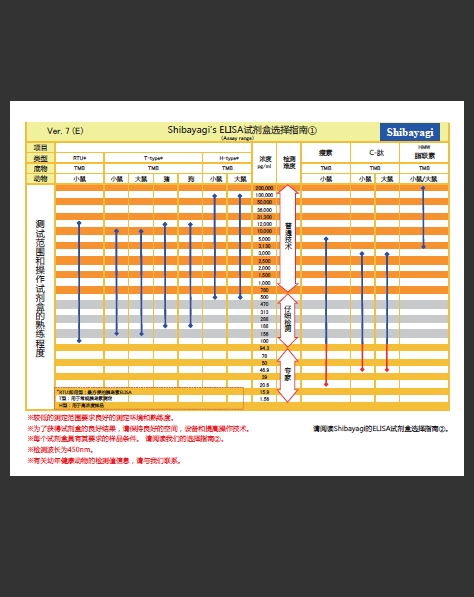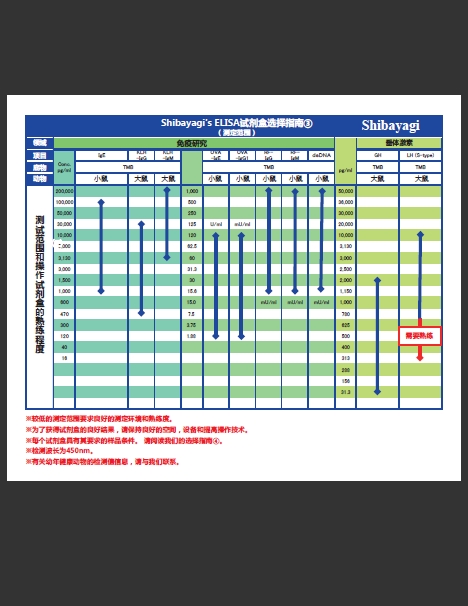- 产品特性
- 相关资料
- Q&A
- 参考文献
LBIS® C-Peptide-Mouse (U type)
LBIS® 小鼠 C-肽 ELISA 试剂盒(U 型)
胰岛素是细胞中的单链胰岛素原合成后,形成二硫键,通过酶分解激活,裂解成C肽与胰岛素。小鼠、大鼠的胰岛素的氨基酸序列相同,但C肽部分稍有不同。小鼠C肽1是 29 个氨基酸,2是 31 个的单链肽。C肽是从胰岛素原分离后,与胰岛素一同分泌生成的。长期以来,人们一直认为C肽没有生物活性,仅在合成胰岛素过程中,保证A链和B链正确折叠以及二硫键正确配对时起作用。近年,随着研究的不断深入,证明了C肽具有多种生物学作用。首先,10-9M 的C肽能与内皮细胞、肾小管上皮细胞和成纤维细胞表面的G蛋白偶联受体结合。激活细胞中钙离子依赖性的信号、激活 Na+-K+-ATPase、促进内皮细胞的 NO 合成、与受体的结合有立体结构特异性;与胰岛素、胰岛素原、IGF-I、-II、NPY 之间无交叉反应。而且通过对缺少C肽的Ⅰ型糖尿病患者注射C肽类药物,能起到增强骨骼肌以及皮肤的血液循环、降低肾小球超滤的风险、抑制白蛋白从尿液中的排泄、改善神经机能的作用。但对身体健康的人来说,这类药物没有此等功效。因此,建议Ⅰ型糖尿病患者可以在注射胰岛素的同时,投放C肽,有利于防止并发症的发生。
C肽的C末端的五肽(27-31)在与受体的结合中起着重要的作用,缺少这部分的 Des(27-31)C肽就会失去它的作用。这种五肽可以完全取代C肽和受体的结合,激活 Na+-K+ATPase。有报告指出新生大鼠中 Des(27-31)C肽的存在量约占C肽总量的37%,而在成年大鼠中只占8.5%。
C肽在血液中的寿命是胰岛素的好几倍。在临床上,可以通过测量C肽在血液中的浓度来观察胰岛素的合成和分泌功能。且C肽在尿液中多量排除,一定程度上与血液中C肽的平均值相关,所以也可以通过尿液来检测。
作为人工胰岛中胰岛素分泌的指标,C肽测量是有效的。由于在培养液中经常添加胰岛素,如果要测量培养后培养液中的胰岛素的话,就不能很好地区别出分泌的胰岛素和添加的胰岛素,必须减掉培养开始时胰岛素的量。这种情况下,如果分泌的胰岛素量过少,测量误差的影响会增大,从而不能做出正确的判断。这时候,如果测量C肽,因为C肽与胰岛素是等摩尔分泌的,所以能够正确判断分泌的胰岛素。
本公司的整套产品能够识别C肽1、2的交叉部分,可以测量C肽的总量。
◆特点
● 短时间测定(完全反应时间:5小时)
● (标准用量 10 μL)可测
● 使用对环境无害的防腐剂
● 全部试剂均为液体,可直接使用
● 精密的测定密度和高再现性
◆构成
|
组成 |
状态 |
容量 |
|
(A) 抗体固相化 96 孔板 |
洗净后使用 |
96 wells(8×12)/1 块 |
|
(B) 标准溶液(6,000 pg/mL) |
稀释后使用 |
500 μL/1 瓶 |
|
(C) 缓冲液 |
即用 |
60 mL/1 瓶 |
|
(D) 抗C-肽抗体生物素结合 |
稀释后使用 |
100 μL/1 瓶 |
|
(E) 过氧化物・抗生物素蛋白结合物 |
稀释后使用 |
100 μL/1 瓶 |
|
(F) 显色液(TMB) |
即用 |
12 mL/1 瓶 |
|
(H) 反应停止液(1M H2SO4)※小心轻放 |
即用 |
12 mL/1 瓶 |
|
( I ) 浓缩洗净液(10×) |
稀释后使用 |
100 mL/1 瓶 |
|
封板膜 |
4 张 |
|
|
使用说明书 |
1 份 |
◆样本
小鼠的血清或血浆
10 μL/well(用本品配备的缓冲液稀释后、50 μL 分注在孔板中。)
◆测定范围
46.9~3,000 pg/mL(标准曲线范围)
234.5~15,000 pg/mL(检体量 10 μL 的时候)
◆Validation data
精度测试(检测内变异系数)
|
样本 |
A |
B |
|
1 |
976 |
238 |
|
2 |
969 |
230 |
|
3 |
965 |
230 |
|
4 |
1023 |
235 |
|
5 |
977 |
231 |
|
6 |
1018 |
228 |
|
7 |
1038 |
229 |
|
8 |
995 |
225 |
|
mean |
995 |
231 |
|
SD |
27.7 |
4.10 |
|
CV(%) |
2.78 |
1.78 |
单位:pg/mL
再现性测试(检测内变异系数)
|
测量日/检体 |
C |
D |
E |
|
第0天 |
1502 |
301 |
60.9 |
|
第1天 |
1500 |
302 |
63.8 |
|
第2天 |
1499 |
301 |
62.2 |
|
第3天 |
1501 |
300 |
58.8 |
|
mean |
1500 |
301 |
61.4 |
|
SD |
1.12 |
0.66 |
2.13 |
|
CV(%) |
0.07 |
0.22 |
3.46 |
单位:pg/mL, n=4
添加回收测试
样本F
|
添加量 |
实测值 |
回收量 |
回收率(%) |
|
0.00 |
300 |
– |
– |
|
265 |
551 |
250 |
94 |
|
398 |
683 |
382 |
96 |
|
531 |
827 |
527 |
99 |
单位:pg/mL, n=2
样本G
|
添加量 |
实测值 |
回收量 |
回收率(%) |
|
0.00 |
58.2 |
– |
– |
|
28.9 |
86.7 |
28.5 |
99 |
|
38.6 |
98.2 |
40.0 |
104 |
|
77.4 |
139 |
80.8 |
104 |
单位:pg/mL, n=2
稀释直线性测试
用稀释缓冲液分三次连续稀释2个血清检体的结果,直线回归方程的 R2 是 1.00 。
欲了解更多相关产品信息,请点击文字:LBIS® 疾病相关动物模型ELISA试剂盒系列
相关资料
 |
 |
 |
| 说明书 |
ELISA试剂盒选择指南①② |
ELISA试剂盒选择指③④ |
参考文献
|
1. |
Inhibition of Gastric Inhibitory Polypeptide Receptor Signaling in Adipose Tissue Reduces Insulin Resistance and Hepatic Steatosis in High-Fat Diet-Fed Mice. Joo E, Harada N, Yamane S, Fukushima T, Taura D, Iwasaki K, Sankoda A, Shibue K, Harada T, Suzuki K, Hamasaki A, Inagaki N. Diabetes. 2017 Apr;66(4):868-879. |
|
2. |
Inhibition of Gastric Inhibitory Polypeptide Receptor Signaling in Adipose Tissue Reduces Insulin Resistance and Hepatic Steatosis in High Fat Diet-Fed Mice. Joo E, Harada N, Yamane S, Fukushima T, Taura D, Iwasaki K, Sankoda A, Shibue K, Harada T, Suzuki K, Hamasaki A, Inagaki N. Diabetes. 2017 Jan 17. |
|
3. |
Insulin Release from the Beta Cells in Acatalasemic Mice Is Highly Susceptible to Alloxan-Induced Oxidative Stress. Kazunori Takemoto, Wakana Doi, Ken Kataoka, Kohji Ishihara, Da-Hong Wang, Hitoshi Sugiyama, Noriyoshi Masuoka. Journal of Diabetes Mellitus, 2015, 5, 81-89 |
|
4. |
Effect of Burdock Root and the Fermented Product on Alloxan-Induced Mouse Hyperglycemia Wakana Doi, Yumi Asada, Ayaka Ohno, Yoshiko Okuda, Shota Masuda, Ayano Matsumoto, Chihiro Mori, Takaya Agarie, Kohji Ishihara, Takayuki Murakami & Noriyoshi Masuoka Journal of Food Research; Vol. 4, No. 4; 201 |
|
5. |
Tissue Complex of Adult Pancreatic Duct and Vascular Endothelial Cells Promotes In Vitro Differentiation into Insulin-Producing Cells. Jun Kanamune, Chongmun Kim, Yasuhiro Iwanaga, Jorge David Rivas-Carrillo, Shoichiro Sumi, Shinji Uemoto and Kazuyuki Yokokawa. J Stem Cell Res Dev 2015, 2: 005 |
|
6. |
Anti-diabetic effect of purple corn extract on C57BL/KsJ db/db mice. Bo Huang, Zhiqiang Wang, Jong Hyuk Park, Ok Hyun Ryu, Moon Ki Choi, Jae-Yong Lee, Young-Hee Kang, and Soon Sung Lim. Nutr Res Pract. 2015 Feb;9(1):22-29. |
|
7. |
Xanthohumol Improves Diet-induced Obesity and Fatty Liver by Suppressing Sterol Regulatory Element-binding Protein (SREBP) Activation. Miyata S, Inoue J, Shimizu M, Sato R. J Biol Chem. 2015 Aug 14;290(33):20565-79. |
|
8. |
Effect of Aspergillus awamori-Fermented Burdock Root on Mouse Diabetes Induced by Alloxan—Prevention of Cell Apoptosis. Kazunori Takemoto, Wakana Doi, Ayumi Zukeran, Junji Inoue, Kohji Ishihara, Noriyoshi Masuoka. Food and Nutrition Sciences, Vol.5 No.16(2014), Article ID:49228,7 pages |
|
9. |
Engineering of pseudoislets: effect on insulin secretion activity by cell number, cell population, and microchannel networks. Kojima N, Takeuchi S, Sakai Y. Transplant Proc. Vol.46(4), p1161-65, May 2014. |
|
10. |
Evaluation of 7-O-galloyl-d-sedoheptulose, isolated from Corni Fructus, in the adipose tissue of type 2 diabetic db/db mice. Park CH., Tanaka T., Yokozawa T. Fitoterapia, Vol.89, p131-142, Sep 2013. |
|
11. |
Periaortic adipose tissue-specific activation of the renin-angiotensin system contributes to atherosclerosis development in uninephrectomized apoE-/- mice. Kawahito H., Yamada H., Irie D., Kato T., Akakabe Y., Kishida S., Takata H., Wakana N., Ogata T., Ikeda K., Ueyama T., Matoba S., Mori Y., Matsubara H. American Journal of Physiology – Heart and Circulatory Physiology, Vol.305, p667-675, Sep 2013. |
|
12. |
Effect of vitamin E on alloxan-induced mouse diabetes. Kamimura W., Doi W., Takemoto K., Ishihara K., Wang D-H., Sugiyama H., Oda S., Masuoka N. Clinical Biochemistry, Vol.46(9), p795-798, Jun 2013. |
|
13. |
Evaluation of 7-O-galloyl-d-sedoheptulose, isolated from Corni Fructus, in the adipose tissue of type 2 diabetic db/db mice. C.H.Park, T.Tanaka, T.Yokozawa. Fitoterapia, Vol.89, p131-42, Sep 2013. |
|
14. |
Therapeutic approach for type 1 diabetes mellitus using the novel immunomodulator FTY720 (fingolimod) in combination with once-daily injection of insulin glargine in non-obese diabetic mice. T.Tsuji, M.Inoue, Y.Yoshida, T.Fujita, Y.Kaino, T.Kohno. Journal of Diabetes Investigation, Vol.3(2), p132-137, Apr 2012. |
|
15. |
Effect of vitamin E on alloxan-induced mouse diabetes. Kamimura W, Doi W, Takemoto K, Ishihara K, Wang D-H, Sugiyama H, Oda S, Masuoka N. Clinical Biochemistry, Mar 2013. |
|
16. |
Intramedullary Cavity as an Implant Site for Bioartificial Pancreas: An In Vivo Study on Diabetic Canine. Y, Kai-Chiang., W, Chang-Chin., S, Shoichiro., K, Tzong-Fu., L, Sheng-Chuan., L, Feng-Huei. Transplantation, Vol. 90(6), p604-611, Sep 2010. |
|
17. |
The in vivo performance of bioartificial pancreas in bone marrow cavity: A case report of a spontaneous diabetic feline. K, C, Yang., C, C, Wu., S, C, Lin., S, Sumi., F, H, Lin. Biochemical and Biophysical Research Communications, Vol.393(3), p362-364, Mar 2010. |
|
18. |
In vitro reprogramming of adult hepatocytes into insulin-producing cells without viral vectors . H, Motoyama., S, Ogawa., A, Kubo., S, Miwa., J, Nakayama., Y, Tagawa., S, Miyagawa. Biochemical and Biophysical Research Communications, Vol.385(1), p123-128, Jul 2009. |
|
19. |
Efficient differentiation of insulin-producing cells from skin-derived stem cells. Guo,W.,Miao,C.,Liu,S.,Qiu,Z.,Li,J., and Duan, E. Cell Proliferation, Vol.42(1), p49-62, 2009. |
|
20. |
Enrichment of Putative Pancreatic Progenitor Cells From Mice by Sorting for Prominin1(CD133)and PDGFRb. Yuichi Hori,Miki Fukomoto,Yoshikazu Kuroda. Stem Cells;0:2008-0192v1,2008 |
|
21. |
Possibility of insulin-producing cells derived from mouse embryonic stem cells for diabetes treatment. T, Ibii., H, Shimada., S, Miura., E, Fukuma., H, Sato., H, Iwata. Journal of Bioscience and Bioengineering,Vol.103(2), p140-146, Feb 2007. |
|
22. |
The dual function of hepatic SOCS3 in insulin resistance in vivo. Torisu, T., Sato, N., Yoshiga, D., Kobayashi, T., Yoshioka, T., Mori, H., Iida, M. and Yoshimura, A. Genes to Cells, 12, p143-154, 2007. |
|
23. |
Prolonged remission of diabetes by regeneration of bold italic beta cells in diabetic mice treated with recombinant adenoviral vector expressing glucagon-like peptide-1. Liu, M.J., Shin, S., Li, N., Shigehara, T., Lee, Y.S., Yoon, J.W., and Jun H.S. Molecular Therapy 15: p86-93, 2007. |
|
24. |
Possibility of insulin-producing cells derived from mouse embryonic stem cells for diabetes treatment. Ibii, T., Shimada, H, Miura, S., Fukuma, E.,Sato, H.,and Iwata,H. J Bioscience Bioengineering 103: p140-146, 2007. |
|
25. |
A human b-cell line for transplantation therapy to control type 1 diabetes. Narushima, M., Kobayashi, N., Okitsu, T., Tanaka, Y., Li, S.A., Chen, Y., Miki, A., Tanaka, K., Nakaji, S., Takei, K., Gutierrez, A.S., Rivas-Carrillo, J.D., Navarro-Alvarez, N., Jun, H.S., Westerman, K.A., Noguchi, H., Lakey, J.R.T.,, Leboulch, P., Tanaka, N., and Yoon, J.W. Nature Biotechnology, Vol. 23(10), p1274-1282, 2005. |
| 产品编号 | 产品名称 | 产品规格 | 产品等级 |
| 635-07239 | (AKRCP-031)LBIS® Mouse C-peptide ELISA kit (U-type) LBIS®小鼠 C-肽 ELISA试剂盒(U型) |
96 tests | – |
